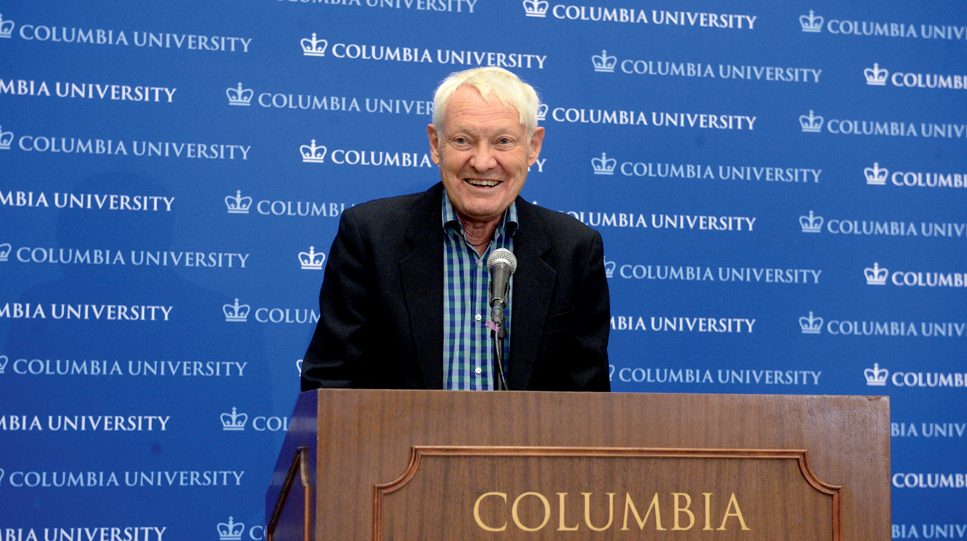Joachim Frank, a Columbia biochemist, won the 2017 Nobel Prize in Chemistry for his role in developing a way to create high-resolution 3D images of biomolecules such as proteins, lipids, and ribosomes. He shares the award with Richard Henderson of the MRC Laboratory of Molecular Biology in Cambridge, UK, and Jacques Dubochet of the University of Lausanne in Switzerland. The trio’s technique, called cryo-electron microscopy, is widely regarded as having revolutionized biological research.
“This method has moved biochemistry into a new era,” reads the Royal Swedish Academy of Sciences’ official prize announcement. “In the past few years, scientific literature has been filled with images of everything from proteins that cause antibiotic resistance to the surface of the Zika virus.”
For scientists who study the inner workings of cells, it is often necessary to know what individual molecules look like. The shape of a protein, for example, can determine its function. But before cryo-electron microscopy became available about five years ago, scientists struggled to produce anything but fuzzy images of these molecules.
Frank, Henderson, and Dubochet changed that. Working separately but in a manner that complemented one another’s advances, they came up with a solution that involved flash-freezing cells so that their constituent parts are locked in their natural configurations (Dubochet’s contribution); shooting electron beams into the cells in order to detect the contours of even the tiniest molecules (Henderson’s contribution); and then translating the resulting data into extraordinarily detailed 3D images (Frank’s contribution).
The technique has already proved indispensable to researchers. Last year, scientists used cryo-electron microscopy to analyze the structure of the Zika virus and to quickly start developing drugs that could disable it. The technique has also given scientists their first close-up views of Salmonella as it attacks cells; of proteins that confer resistance to certain chemotherapies and antibiotics; and of the complex molecular interactions that govern our circadian rhythms.
“Now we can see the intricate details of the biomolecules in every corner of our cells, in every drop of our body fluids,” says Sara Snogerup Linse, a Swedish scientist who chairs the Nobel committee for chemistry.
Frank, who was born in Germany during World War II, received degrees from the Universities of Freiburg and Munich before earning a doctorate in physics from the Technical University of Munich in 1970. Over the next few decades, he held positions at a number of academic institutions in Germany, the United Kingdom, and the United States, all the while researching the computational-imaging methods that eventually made cryo-electron microscopy possible. He joined Columbia as a professor in the Department of Biochemistry and Molecular Biophysics and the Department of Biological Sciences in 2008.
In his own research, Frank has used cryo-electron microscopy to investigate the interactions between ribosomes — which serve as the “protein factories” of the cell — and other molecules. In a 2013 paper in Nature, he uncovered new details about the ribosomes of a parasite that causes African sleeping sickness; that discovery is now guiding efforts to develop new treatments for this disease. In another Nature paper the same year, he revealed how the RNA molecules of many viruses can commandeer the ribosomes of their hosts’ cells to produce new viruses.
Speaking to journalists at Butler Library after the announcement of his prize on October 4, Frank expressed gratitude to “all of the postdocs, students, and research associates” who “contributed pieces of this immense puzzle over the years.” He said that his move to Columbia was crucial in the development of cryo-electron microscopy, both because of the high-caliber students he was able to recruit to his laboratory here and because of the University’s support for interdisciplinary research.
“There has been wonderful support, and generous gifts, that have made possible the acquisition of new instrumentation,” he said.
Which is not to say Frank was prepared for the 5:18 a.m. phone call from the Swedish Academy telling him he had won the Nobel.
“All I could say was, ‘This is such wonderful news,’” he recalled. “I said it over and over again.”



